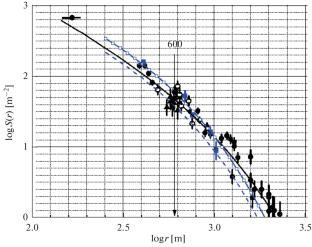雅库茨克广泛空气阵雨阵列探测到的巨大大气阵雨
IF 0.48
Q4 Physics and Astronomy
Bulletin of the Russian Academy of Sciences: Physics
Pub Date : 2025-07-15
DOI:10.1134/S1062873825711341
引用次数: 0
摘要
本文考虑了1974-2024年整个观测期间在雅库茨克EAS阵列记录的两个能量约为1020 eV的最强大的广泛空气阵雨(EAS)。两个阵雨都击中了靠近中心的阵列,触发了所有地面探测器和地下μ子探测器,阈值能量为Eμ = 1.0 × cos θ GeV。这些事件具有异常高的μ子比例,这超出了当前模型的预测。这可能会改变我们对超高能量强子相互作用的理解,但也有可能这些阵雨是由一些奇异的初级粒子引发的。本文章由计算机程序翻译,如有差异,请以英文原文为准。

Giant Atmospheric Showers Detected by the Yakutsk Extensive Air Showers Array
The two most powerful extensive air showers (EAS) with energies of about 1020 eV, registered at the Yakutsk EAS array during the entire observation period of 1974–2024, are considered. Both showers hit the array near the center and triggered all surface detectors and underground muon detectors with a threshold energy of Eμ = 1.0 × cos θ GeV. These events have an abnormally high fraction of muons, which is beyond current model predictions. This may change our understanding of hadron interactions at ultra-high energy, but there is also a possibility that these showers were initiated by some exotic primary particles.
求助全文
通过发布文献求助,成功后即可免费获取论文全文。
去求助
来源期刊

Bulletin of the Russian Academy of Sciences: Physics
Physics and Astronomy-Physics and Astronomy (all)
CiteScore
0.90
自引率
0.00%
发文量
251
期刊介绍:
Bulletin of the Russian Academy of Sciences: Physics is an international peer reviewed journal published with the participation of the Russian Academy of Sciences. It presents full-text articles (regular, letters to the editor, reviews) with the most recent results in miscellaneous fields of physics and astronomy: nuclear physics, cosmic rays, condensed matter physics, plasma physics, optics and photonics, nanotechnologies, solar and astrophysics, physical applications in material sciences, life sciences, etc. Bulletin of the Russian Academy of Sciences: Physics focuses on the most relevant multidisciplinary topics in natural sciences, both fundamental and applied. Manuscripts can be submitted in Russian and English languages and are subject to peer review. Accepted articles are usually combined in thematic issues on certain topics according to the journal editorial policy. Authors featured in the journal represent renowned scientific laboratories and institutes from different countries, including large international collaborations. There are globally recognized researchers among the authors: Nobel laureates and recipients of other awards, and members of national academies of sciences and international scientific societies.
 求助内容:
求助内容: 应助结果提醒方式:
应助结果提醒方式:


